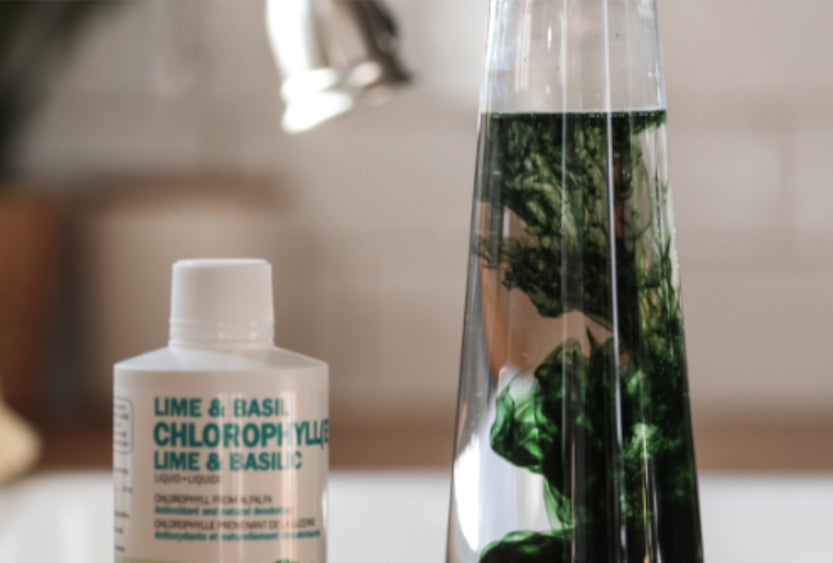

Chlorophyll: Essential to Life – Origin & Benefits
Present in plants, algae, and cyanobacteria, chlorophyll is the green pigment that gives colour to tree leaves and plants. Chlorophyll is responsible for photosynthesis, a process that, from light, carbon dioxide, and water, produces sugars called carbohydrates (energy). (27, 28) Chlorophyll is therefore essential to life as it allows the entire food chain to feed on the energy it produces.
It is photosynthesis and therefore chlorophyll that is also the source of virtually all the oxygen we breathe on Earth. (38)
Chlorophyll is therefore essential to our life and survival. Even though it is so small to our eyes, chlorophyll is ubiquitous and plays a big role on Earth.
Types of chlorophyll
In its natural state, there are five types of chlorophyll, four of which are dominant in the plant kingdom and another type that is exclusive to the world of microorganisms (prokaryotes).
Chlorophyll A: Found in plants, algae, and cyanobacteria.
Chlorophyll B: Found in green plants and algae.
Chlorophyll C: Found in diatoms, brown algae, and dinophytes.
Chlorophyll D: Found only in red algae.
Chlorophyll E: Found in some prokaryotes.
Several types of chlorophyll coexist but the two main types are chlorophyll a and chlorophyll b. In general, chlorophyll A is found three times more than chlorophyll B. (30)
Molecule
Have you ever heard that chlorophyll is the blood of plants? Some even say that the chlorophyll molecule resembles our red blood cells. In fact, they have several similarities, but chlorophyll is very different from our red blood cells. Indeed, although the two molecules have a similar ring, we can see that the hemoglobin has an iron atom in its center while the chlorophyll has a magnesium atom. Also, the branching of the chlorophyll molecule is longer, and it also makes it insoluble in water. (31) In its natural state, chlorophyll is therefore soluble in lipids (oils). You cannot dilute it in water.

Why take chlorophyll?
There are many health benefits to consume chlorophyll on a daily basis and scientific evidence is accumulating. Here are the key health benefits recognized by Health Canada as well as other positive effects that are currently being studied.
Health Benefits of Chlorophyll Recognized by Health Canada
Health Canada recognizes and allows health claims to be made on two levels.
1. Its antioxidant power
Chlorophyllin’s antioxidant capacity is about 2000 times greater than that of blueberry juice and 20 times greater than that of resveratrol, an organic molecule recognized as one of the best tools to fight oxidative damage induced by chemical carcinogens and radiation.So, it is a great way to fight free radicals daily! (5,10)
2. Its internal deodorant power
Chlorophyll has the ability to reduce bad breath, food odors, perspiration odors, and intestinal odors.
It is thanks in part to its ability to bind to certain organic molecules responsible for bad odors such as putrescin and cadaverine that chlorophyll succeeds in neutralizing bad odors. Other studies have shown highly beneficial effects in patients who have undergone a colostomy (11,12).
Other known health benefits according to the consulted research
Although two health claims are already permitted by Health Canada, several other health benefits of chlorophyll are currently being studied and the results are promising.
Here are a few:
1. Detoxifying
Chlorophyll binds to aflatoxins and promotes their elimination (detoxification). (8) Aflatoxins are toxins produced by microscopic mold on peanuts, among other things. They are very dangerous to the liver, and because they bind to DNA, can cause cancer. Chlorophyll can also disable intermediate aflatoxin-DNA compounds that trigger cancer. (2,9,10)
Another study would show that taking chlorophyll could help the body eliminate other dangerous toxins (triethylamines). (7)
2. Cancer prevention and treatment of colon cancer.
Studies show that chlorophyllin has promising effects in cancer prevention as it would be able to prevent the mutation of our cells and fight the free radicals responsible for damaging our cells thereby causing long-term cancers. (2,3,17) Chlorophyllin would also have a therapeutic effect in the treatment of colon cancer by acting on ribonucleotide reductase. (14)
3. Anti-Inflammatory
Studies also show that chlorophyll, particularly type A chlorophyll, has remarkable anti-inflammatory effects by inhibiting cytokines responsible for inflammatory reactions. (25) Chlorophyll would therefore be an ingredient with great potential in the development of new skin drugs.
4. Healing abilities
Several studies (22,23,24) show encouraging effects in skin healing. Topical application of a gel containing chlorophyll to a wound would speed up skin healing and help prevent infections. It is also suspected that the anti-inflammatory properties of chlorophyll would help in the healing of the skin.
5. Anti-aging effects on skin
Also, contained within a gel applied to the skin, chlorophyll shows very promising effects to reduce the signs of aging caused by sun exposure. Its anti-aging and anti-wrinkle effects would even be comparable to some creams prescribed by dermatologists (creams containing retinoic acid/tretinoin). But that is not all, another study showed that chlorophyll could act by protecting the body, especially the skin, from ionizing radiation such as gamma rays. (15)
6. Acne treatment
Applied topically, chlorophyll also has very interesting effects in the treatment of acne. Studies show that its antioxidant, anti-inflammatory, and healing effects reduce the number of lesions, the severity of acne, and the level of sebum after 3 weeks of treatment (19,20).
7. Increased white blood cell production (immune system)
Indeed, a Chinese study has shown that taking 120mg of chlorophyll increases the production of white blood cells in leukopenic patients (who do not have enough white blood cells). (6)
How can I get more chlorophyll?
Chlorophyll in your diet
The first thing to do is to incorporate sources of chlorophyll into your diet. Adding more green vegetables into your diet is the first step. These vegetables are not only rich in chlorophyll, but also in vitamins and minerals that are good for your health. The key is to consume it regularly, every day. You do not have to eat salad alone. Vary your greens. Add salad as a side dish on some days. Steam broccoli. Add a little spinach into your stir-fry. Cook beans. Eat green peas every now and then. If you are already making smoothies in the morning, do not hesitate to incorporate some green vegetables into your smoothies. The key is to integrate them into your regular eating habits. But wait! Because chlorophyll is sensitive to heat, do not cook your greens for too long.
On the other hand, chlorophyll in our diet is difficult to absorb for two main reasons. Chlorophyll is contained in protective cells (chloroplasts) that will not all be broken down when we eat our meals. Also, this chlorophyll is contained in the oil. Consequently, the literature indicates that a low 4% of this chlorophyll is actually absorbed. (26)
As studies have shown that the amount of chlorophyll needed to maximize beneficial effects is about 100 mg per day and that only 4% of the chlorophyll in food is absorbed, this means that you need to eat the equivalent of 50 cups of parsley or 100 cups of spinach per day to assimilate 100 mg of chlorophyll daily. These quantities are clearly impossible to consume on a daily basis!
The table below shows the amount of chlorophyll contained in different sources and the amount actually absorbed by our body. (39)
Portion Chlorophyll (mg) Absorption (mg)
Parsley, 1 cup 48.0 1.9
Spinach, 1 cup 23.7 0.95
Cresson, 1 cup 15.6 0.6
Green beans, 1 cup 8.3 0.33
Arugula, 1 cup 8.2 0.33
Endives, 1 cup 5.2 0.2
Green peas, 1 cup 4.8 0.19
Chlorophyll supplements
Although diet is the easiest way to increase our chlorophyll intake, taking a chlorophyll supplement has great benefits.
First, a supplement of chlorophyll ensures that you take the same dose every day. In comparison, it is impossible to know exactly how much chlorophyll we consume through our diet...
Secondly, a true chlorophyll supplement makes it possible to benefit as much as possible from chlorophyll, because in this case, it is water-soluble and much easier to absorb. Through food, studies show that we absorb only 4%!
To help you choose the right chlorophyll supplement, 5 criteria must be met:
1-Do not get confused between chlorophyll, chlorella, spirulina, and greens
Not all green supplements are equal! Chlorella, spirulina, and greens do not provide the benefits of chlorophyll. The chlorophyll they contain is not bioavailable.There is no substitute for a real chlorophyll supplement. And contrary to what many may believe, a true chlorophyll supplement contains only chlorophyllin and does not contain vitamins, minerals, or proteins. You only get chlorophyll in a truly bioavailable form.
2-Know the source of your chlorophyll's origin
Chlorophyll can be extracted from any botanical source rich in chlorophyll, but in a practical and commercial way, it is extracted mainly from mulberry leaves (Morus alba) or alfalfa (Medicago sativa). In the case of the mulberry leaf, its extraction is not very sexy. Since silkworms feed exclusively on mulberry leaves, mulberry chlorophyll is extracted from the feces of silkworms! Its extraction involves volatile chemical solvents whose traces are still present in the product consumed.
In the case of alfalfa, chlorophyll is extracted directly from alfalfa shoots, and interesting fact, its growth is rapid, and its cultivation does not deplete the soils. It is for all these reasons that our Land Art chlorophyll come exclusively from GMO-free alfalfa and is cold extracted without chemical solvents.
3-Choose a liquid form.
It is well known that a liquid supplement is easier to absorb than a supplement in capsule or tablet form. For this reason, if you can, choose chlorophyll in liquid form because it will be more bioavailable and thus you will easily get the maximum of its health benefits.
4-Select the right concentration.
Several concentrations are available, and it is easy to get confused in front of so many choices! The more concentrated the liquid chlorophyll, the more the herbaceous taste will be present and the less noticeable the added flavour will taste. If it is your first experience, choose a lower concentration. If you are already a regular consumer, that flavour is less important to you and you like the herbaceous taste, try a higher concentration because it will be more economical for you.
5-Know the type of extraction that was used for your chlorophyll supplement
To promote the assimilation of chlorophyll, the chlorophyll pigment must first be isolated by removing it from the chloroplast. This operation is relatively easy to perform by grinding followed by extraction with an organic solvent since chlorophyll is an oil. There are several extraction techniques possible: good, bad, and very bad!
Since you must use an organic solvent to do the extraction, the worst way to do this work is to use solvents that are harmful to your health considering that a certain amount of the solvent remains in the extract. (Ex: ethyl acetate, benzene, chloroform, dichloromethane, methanol, etc.)
Other bad extraction is to use solvents that are more harmful to health. (e.g., ethanol, propylene glycol)
And the best-known extraction method to date is called supercritical extraction, which involves using very cold liquid carbon dioxide (because it is kept under very high pressure) during extraction. Once the extraction is complete, the high pressure is released allowing the CO2 to return to its gaseous form, be recovered and used for other extraction cycles.
The extraction results in a mixture of chlorophylls in almost pure oil form, regardless of the plant material used. As this chlorophyll in oily form is difficult to assimilate, it must then undergo a transformation that makes it water-soluble and therefore easily assimilated by our body. This transformation is called saponification. Chlorophyll saponification uses soda (NaOH) or potash (KOH) in the presence of copper. The resulting chlorophyll salt is called chlorophyllin. Soda gives us copper sodium chlorophyllin while potash gives us copper potassium chlorophyllin. During this transformation, the magnesium atom of chlorophyll is replaced by a copper atom. It should be noted that all liquid and soluble chlorophyll water supplements on the market have undergone this treatment otherwise chlorophyll would simply not be water-soluble!
At this point, it is important to demystify the presence of copper because some mistakenly believe it is a toxic element. Nothing is falser, because copper is essential to our body. It is one of several metabolic reactions essential to the proper functioning of our body. We do not have to rely on the chlorophyll supplement to bring us the copper we need daily because according to Health Canada, the average daily dose of copper required would be about 4 mg. A 100 mg dose of copper sodium chlorophyllin provides only 0.02 mg of assimilable copper so do not assume that the chlorophyll supplement is also a copper supplement.
Land Art chlorophyll is unique and the purest. Made only from GMO-free alfalfa, it is extracted by a supercritical process without chemical solvents. Available in many flavours and concentrations, there is definitely one which is ideal for you! Simply dilute it in water or incorporate it into your smoothie.
This blog was sourced from landart.ca



